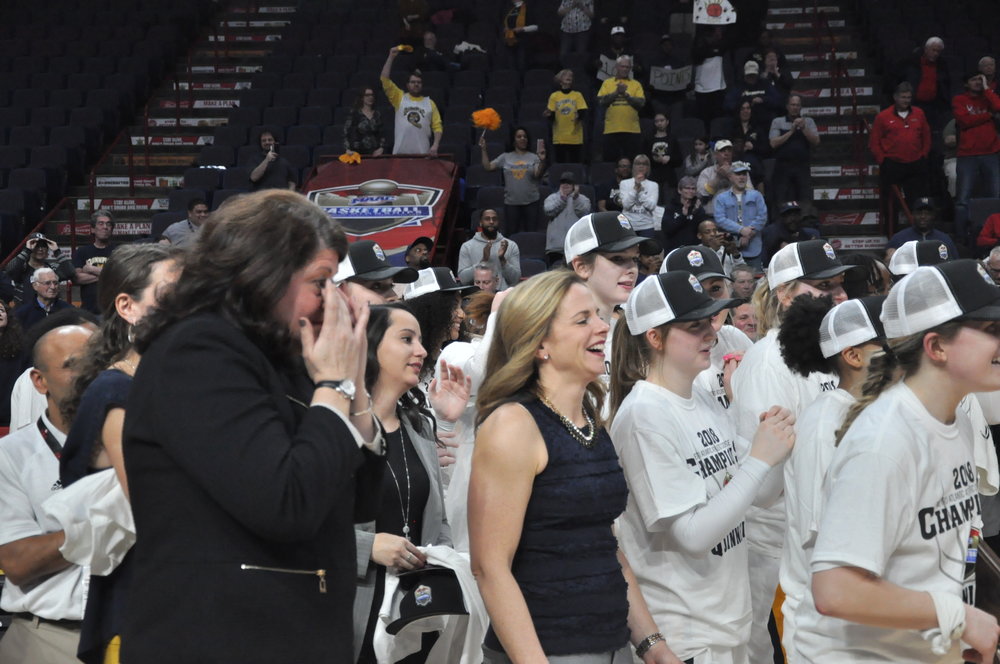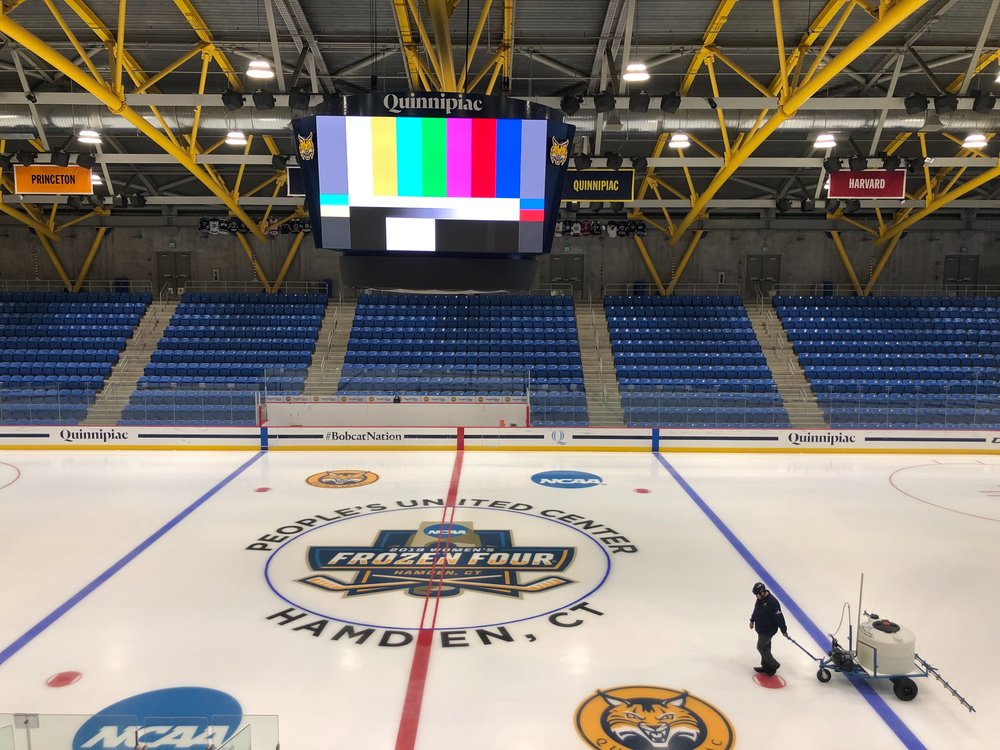
An International sQUad
By Tom Krosnowski
By Tom Krosnowski
It’s an interesting paradox – Earth’s population is growing exponentially, currently estimated at some 7.7 billion people. Why then, does it seem like the world is only getting smaller?
Although it’s on a much smaller scale, the Quinnipiac Bobcats are an interesting example of this phenomenon.
Quinnipiac University is a small private institution in Hamden, Connecticut. Most of the students who attend the school are from the American Northeast, and approximately 97 percent of the student body comes from somewhere within the United States.
However, it’s on the athletic fields where Quinnipiac’s commitment to international recruitment really shines.
In their never-ending search for team success, the coaches of Quinnipiac’s 21 Division-I teams have reached out overseas. International recruitment is a growing part of the collegiate athletics industry, and it’s something that has become a distinct part of the Quinnipiac Bobcat identity.
How do you think an athlete gets recruited? It seems simple enough – a coach finds potential student-athletes, talks to them, watches them play and maybe offers them a scholarship.
That’s not the case for many of Quinnipiac’s international recruits.
Meet Queenie Lai. A junior from Hong Kong, Lai could almost describe her recruitment process as “reverse recruiting.” Lai was an exceptional golfer back home, but wanted a new challenge on the links at a more competitive level. After an admittedly-late start to the recruitment process, Lai took it upon herself to achieve her goal of playing U.S. collegiate golf.
“I had to play in the States for a whole summer of tournaments, state-to-state,” Lai said. “And, I had to contact at least 50 schools and the coaches and introduce myself and ask if they were interested in recruiting me. Eventually, I landed on Quinnipiac and the coach I have right now. He was one of the nicest, and that meant a lot to me.
“I had to do most of the work.”
It’s certainly a much different story than the common assumption of university-paid travel, lavish dinners and unlimited budgets. However, Lai is not the only Quinnipiac athlete with an unconventional recruitment story.
>
“I had to do most of the work.”

Courtesy: Quinnipiac Athletics
Bianca Strubbe was at a crossroads. After playing field hockey in her native Poland for 14 years, Strubbe needed a break. She traveled to the United States, settling in West Hartford as an au pair. Her love of field hockey not yet entirely quelled, Strubbe went to a Quinnipiac field hockey game at the suggestion of her host family.
After liking what she saw on the field and in the state-of-the-art facilities, Strubbe decided to bring field hockey back into her life. She played and coached at a local HTC field hockey club team, but never would have found college field hockey if not for a friendly co-worker, who informed her that she’d likely be eligible to play in the NCAA.
“I didn’t know that, to be honest,” Strubbe said. “None of my friends or Polish players know that we are very welcome in the U.S. playing in college. We don’t have any agencies, we don’t have any connection with U.S. colleges, so, to be honest, we don’t know that we have the chance to earn our degree and play field hockey here.”
Now in her second year as a graduate student at Quinnipiac, Strubbe has made a seamless transition. She’s the team’s leading scorer this season, and her English has improved immensely, thanks in part to her choosing journalism for her major.
Although foreign students are often taught English, the field hockey team is careful to keep an international influence around to keep their players comfortable.
“It’s good to have someone who has the same accent as me,” Strubbe said. “We feel comfortable, we don’t feel afraid to talk. It’s good to have international students around you.”

Courtesy: Quinnipiac Athletics
>
“We don’t know that we have the chance to earn our degree and play field hockey here.”
Quinnipiac women’s ice hockey forward Sarah-Eve Coutu-Godbout didn’t quite have that same luxury. Although she was one of seven international players on the team her freshman year, all Canadians, she was the only one who predominantly spoke French. Fortunately, head coach Cassandra Turner did her best to help Coutu-Godbout adapt.
“Cass knew right off the bat that I couldn’t really speak English, so she was very patient,” Coutu-Godbout said. “She sent me recommendations and books to read to practice my English, as well as helping me with all the stuff I needed to do. For me, that’s exactly what I needed. The integration here in the U.S. was pretty smooth because of the coaches.”
Much like Strubbe, Coutu-Godbout wasn’t initially aware of the opportunity she had to play in the United States, albeit for different reasons.
“In Quebec, they want to maintain all the Quebec players in Canada. It’s kind of against them to go to the U.S.,” Coutu-Godbout said. “So a lot of the teams won’t help you get a spot on a (U.S.) team, so I was pretty much doing it by myself.
“The girls (in America) can be recruited at 13, but in Quebec, it’s another world. They want to keep it away, they don’t want you to come here.”
Even though her peers didn’t want Coutu-Godbout to play college hockey stateside, she wouldn’t have it any other way.
“I really enjoy it here,” Coutu-Godbout said. “I think it’s the perfect choice for me, and I’m really happy about it. I never looked back on it.”
>
“In Quebec, it’s another world. They want to keep it away, they don’t want you to come here.”

Courtesy: Quinnipiac Athletics
How much can you learn about someone through a computer screen? According to the coaches at Quinnipiac, quite a bit.
“This generation is a little different,” men’s soccer coach Eric Da Costa said. “Unfortunately, communication is a little bit harder in terms of getting on the phone and having a phone conversation, so we do a lot of Skype, we do a lot of WhatsApp, FaceTime, just trying to get that time with the guys and figure out who they are, what they’re about, what makes them tick, and (if) that fits into what we do here.”
If Da Costa and his coaching staff have the ability to travel overseas to visit a player, they will. More often than not though, the soccer team recruits its players over the internet due to budgetary and travel restrictions.
“We have to be cautious about how we spend our money,” Da Costa said.
According to Da Costa, it’s easier to recruit international soccer players than Americans.

Courtesy: Quinnipiac Athletics
“Recruiting the American kids is actually a lot more difficult for us,” Da Costa said. “They want the glitz, they want the glamour. They know the differences between the institutions in terms of prestige or popularity, so they look their nose down at us.”
Once coaches have a good experience with a player from a certain area, they are more likely to revisit that region in future recruiting. Take Quinnipiac field hockey, for example. Head coach Becca Main has presided over the program for all 25 years of its existence, and has designated “pockets” of international talent. The team likes to focus its recruiting efforts in areas like South Africa, the Netherlands, Germany and Spain, where several successful players have come from before.
Field hockey is uniquely positioned for international recruiting, compared to some of Quinnipiac’s other sports. According to Main, international players are the preferred recruits for the program due to their added experience.
“(International recruits) have almost 10 years on an American student – they’ve been playing 10 years longer,” Main said. “In general, most Americans have been playing 4-6 years, max. … You get (an international) coming in, they’ve got 16 years (of experience). They’re just better at playing the sport.”
With all of the different languages and cultures on the team, Main tries to make sure that each international player has at least one other teammate who speaks their language. It could be hard to mesh all these different pieces together, but creative thinking from the coaching staff makes it all fit.
“I think the best thing about our international players is that, the ‘groupthink mentality’ – we don’t have that anymore,” Main said. “We have the ability to think outside the box.”

Courtesy: Quinnipiac Athletics
Athletic recruitment is one thing, but these are still “student”-athletes. The players must fit into Quinnipiac’s academic profile, and the admissions department gives very clear outlines to the coaches about what requirements each student-athlete needs to be accepted into Quinnipiac, from English language scores to academic grades.
Andrew Antone, director of international recruitment and admissions at Quinnipiac, says that once the students get to Quinnipiac, the school has several resources to help international students adapt.
“We have a global partners program where students are mentored by upperclassmen, and say, ‘OK, this is how you make the transition,’” Antone said. “We have global education, where they can be with other students. We have an international student orientation, which I think is a big help for them.”
To continue to attract international students, the university has initiated a new “Strategic Plan” that emphasizes globalization among the steps toward becoming the university of the future. Antone believes that the strategic plan will help make Quinnipiac even more appealing to international students.
“Especially with the new strategic plan, I think you’re going to see that number (of international students) grow, given what we’re offering,” Antone said. “The way that we’re looking forward … I think what the strategic plan does is force us to look within and change some of the policies and the way we do things to enhance everyone else’s experiences.”
In all, there are about 70 international student-athletes from more than 20 countries. That may not sound like a lot with Quinnipiac’s student population of over 10,000 and a core of student-athletes almost 500 deep.
To the international players though, it’s not about the numbers. It’s about the experience – an experience that has made Quinnipiac athletics more diverse, and more talented.
“I feel like I’m experiencing the same college experience as other people,” Lai said. “I wouldn’t say it’s any different than how they’re experiencing it.”
Quinnipiac isn’t as well-known as some other Division-I programs. None of the 10 international students interviewed said they knew anything about Quinnipiac before they were first recruited. Once they hear about all the school has to offer them, it’s hard to say no.
“We’ve closed those gaps with this (soccer) facility, obviously our institution, our campus,” Da Costa said. “At the end of the day, an international kid and his family want to go to a place where they’re cared about. They want to go to a place where they can study and play at two high levels. They want to go to a place where they can feel safe – and enjoy.
“And we can offer all of that.”






